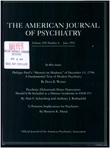The clinical presentation of command hallucinations in a forensic population
Abstract
In a forensic population, patients with command hallucinations (N = 25) were compared to two groups of psychotic patients: those with noncommand hallucinations (N = 24) and those without hallucinations (N = 16). The three groups did not differ in overall impairment as measured by the Global Assessment Scale and the Social Behavior Rating Schedule. However, the group with command hallucinations differed in the content of their hallucinations (more aggression, dependency, and self-punishment themes), and nearly one-half did not report or denied their command hallucinations to the assessment team. Many patients (N = 11, 44%) reported that they frequently responded to hallucinatory commands with unquestioning obedience.
Access content
To read the fulltext, please use one of the options below to sign in or purchase access.- Personal login
- Institutional Login
- Sign in via OpenAthens
- Register for access
-
Please login/register if you wish to pair your device and check access availability.
Not a subscriber?
PsychiatryOnline subscription options offer access to the DSM-5 library, books, journals, CME, and patient resources. This all-in-one virtual library provides psychiatrists and mental health professionals with key resources for diagnosis, treatment, research, and professional development.
Need more help? PsychiatryOnline Customer Service may be reached by emailing [email protected] or by calling 800-368-5777 (in the U.S.) or 703-907-7322 (outside the U.S.).



